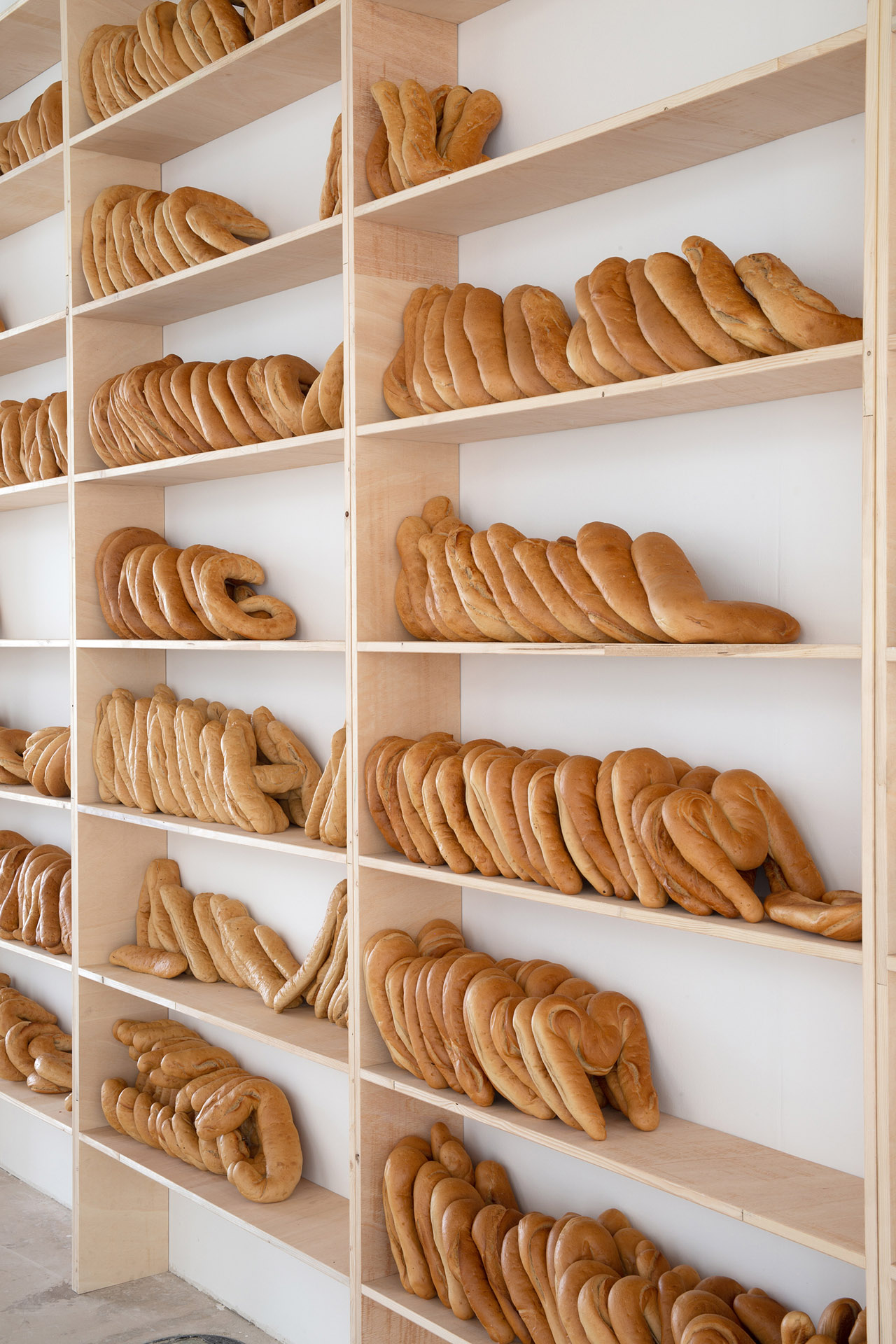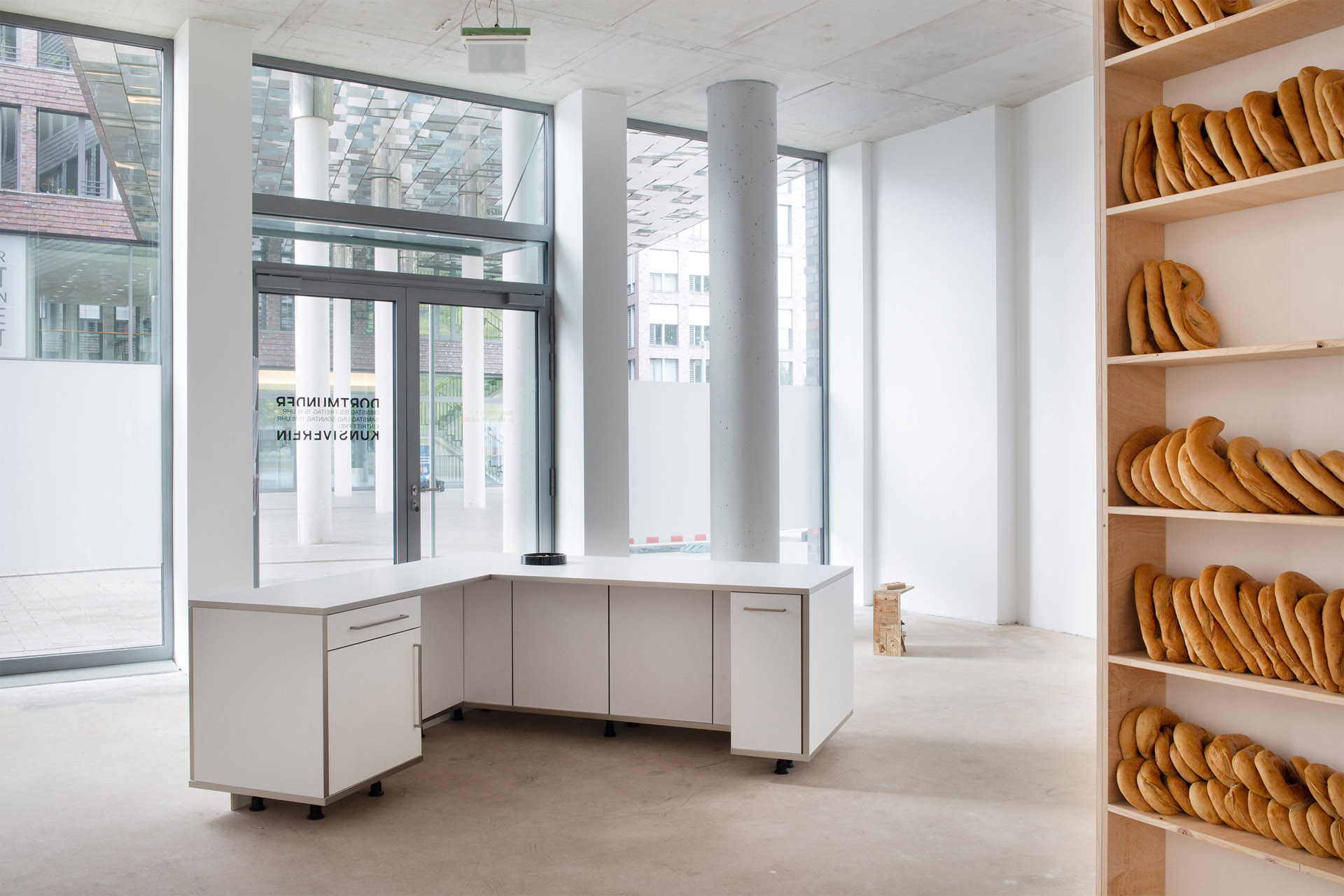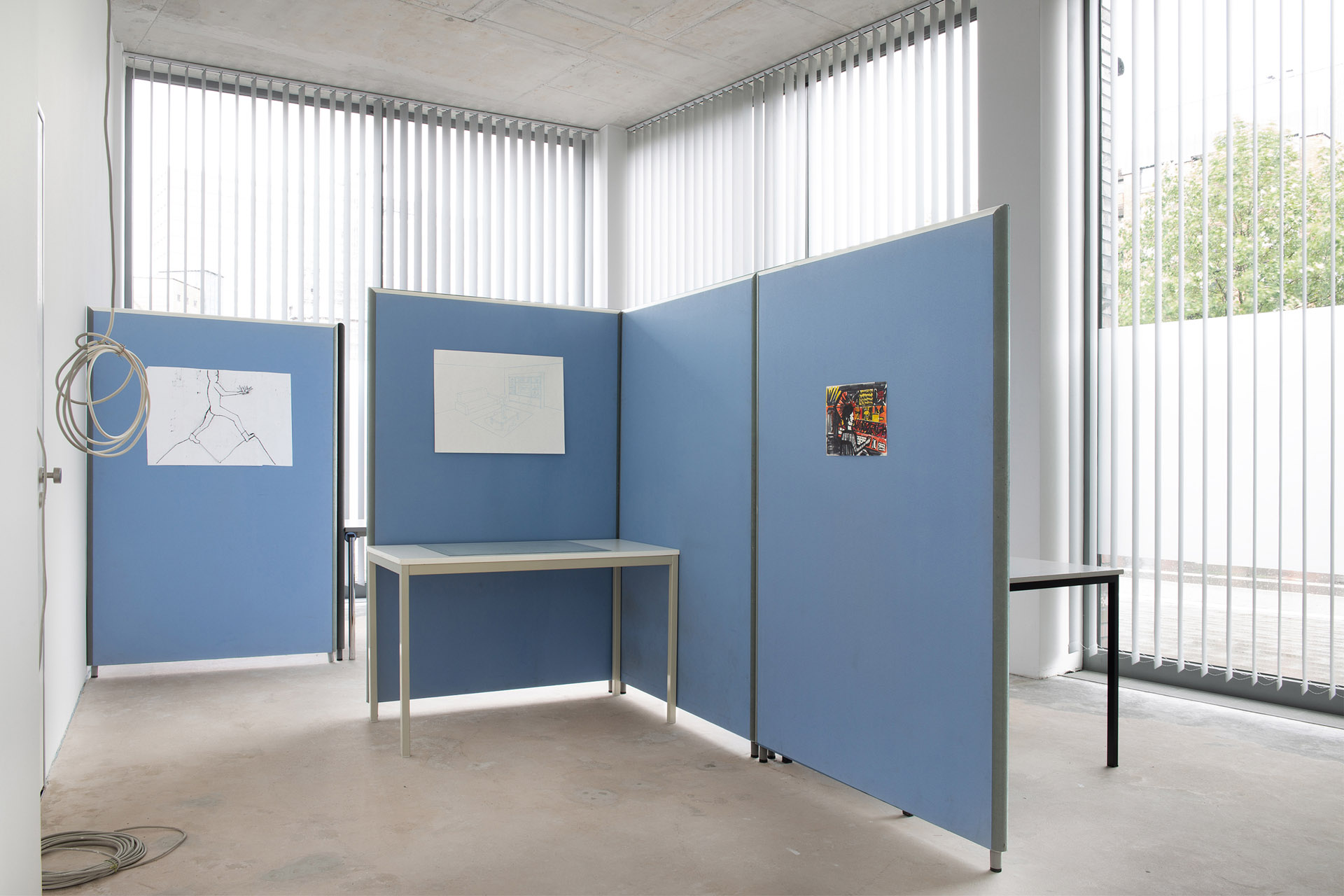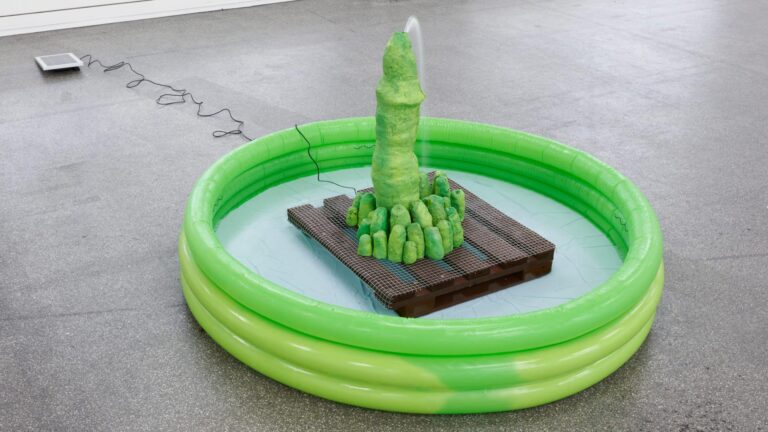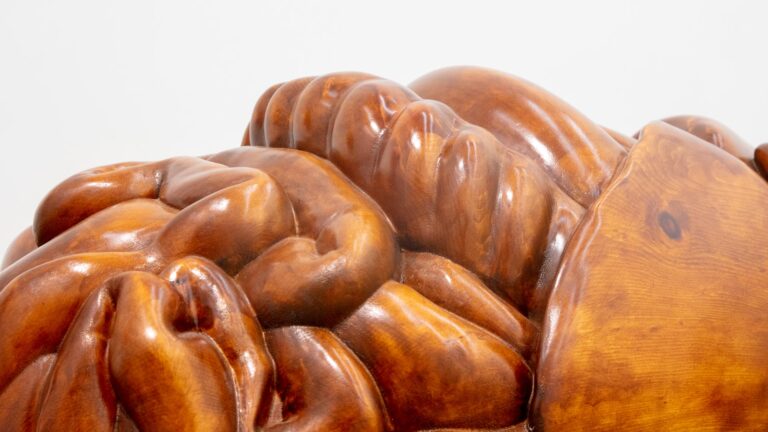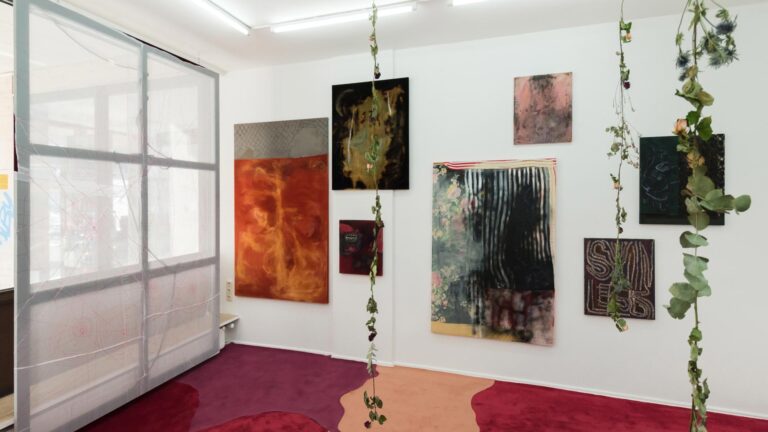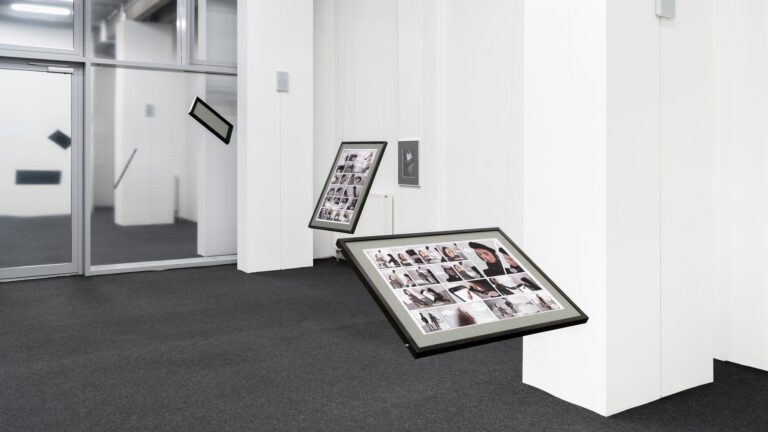Artists: Uri Aran, Oded Avramovsky, Marianne Berenhaut, Max Ernst, Avner Ben Gal, Noa Glazer, George Grosz, I. S. Kalter, Talia Keinan, Martin Kippenberger, Harel Luz, Roy Menachem Markovich, Lee Nevo, Tchelet Ram, Ariel Schlesinger, Shay-Lee Uziel
Exhibition title: Blade Memory II
Curated by: Naama Arad, I. S. Kalter and Eran Nave
Developed in collaboration with: CCA Tel Aviv-Yafo
Venue: Dortmunder Kunstverein, Dortmund, Germany
Date: May 21, 2021 – July 31, 2022
Photography: all images copyright and courtesy of the artist and Dortmunder Kunstverein
“Blade Memory” is an exhibition in two chapters curated by the three Israeli artists Naama Arad, I. S. Kalter and Eran Nave. Its title evokes an aching memory, a memory that strikes to the heart, which should be understood on both a personal level and that of social developments. The artist-curators see each of the works as a kind of holder of time.
Chapter 1 was shown at the CCA Tel Aviv-Yafo, and took a critical look at the idea of art as something ‘produced’. Chapter 2 at Dortmunder Kunstverein examines the role of artists whose present is marked by the disenchantment that professionalisation, corporate branding and its architectures have left in the individual’s sense of agency since early modernity. The world began to accelerate increasingly in last third of the 20th century: densified inner cities leave little room for individual expression; the time economy of digitalisation is optimising global effectiveness, creating not less but more work for some and none for others. Structures of capital and power are consolidating.
The exhibition takes place in the shell of the new premises of Dortmunder Kunstverein, which were formerly used as an insurance office. Artists and insurance offices are joined in a Kafkaesque love-hate relationship that exemplifies social developments – but also awakens ambivalent memories of bureaucratic coldness or of the predictability and stability that such places still emanate. Through digitalization and the pandemic, vacant office space increasingly represents a turning point: the ruins of the early 2000s office architecture now provides a space to look at the world in its status quo, to order it, to contextualise it. Rather than exaggerating and overwhelming, the sober setting of this backdrop allows the art to appear incidental, giving it a chance to reclaim its autonomy outside the spectacle.
Some of the sculptures, drawings and paintings shown here deal materially or in their content with simple everyday office materials, and are in search of a space of individual expression within the institutional and bureaucratic grid of efficiency. At the same time they are objects that refer to memories of the past:
The clock by Lee Nevo (*1984), with its somewhat ageing design, its hands pushing a mountain of cigarette stubs around, or the wooden computer by Shay-Lee Uziel (*1978), in which a rabbit made of spat-out sunflower-seed shells perches on a miniature table, can both be seen as homages to slowing down – the artists’ response to the efficiency machines of digitalisation. As the drawing of a photographic self-portrait after a shower, the work by Dortmund-born Martin Kippenberger (1953–1997), probably from the year 1973/4 and exhibited here for the first time, is the equivalent to a media doubling of memory. The drawings by Oded Avramowsky (*1956), integrated into office tracts and furniture, bring about a conflict-ridden encounter between rationality and dream. And the “Bread Library” (2020/22), by Uri Aran (*1977), which reproduces the Latin alphabet in carefully sorted block letters, is a loavely collection of utensils for the production of text. The work asks how everyday activities can be used to produce meaning. The letters can notionally stand for all kinds of sentences: poetic, bureaucratic, objective, academic, emotional, personal.
Plants bleached with cleaning fluid in the work of Tchelet Ram (*1982), a textile sculpture filled with toxic glassbuds by Noa Glazer (*1981) or Roy Menachem Markovitch (*1979)’s modernistic sculpture made of garden hoses and cables are examples of a poetic repurposing of everyday materials in this exhibition. Markovitch’s sculpture looks something like the sketch of a sculpture in the foyer of a bank, a place where for decades artworks have been used as the symbols of power and expression of potency. This idea is underlined by the pharma company Pfizer’s Viagra pill enlarged by Harel Luz (*1979).
The ascent to the gallery on the upper floor is a transit to the level of power, and is bathed in orange light (a reference to Blade Memory I): in a carpeted room stands on oversized conference table. At one end the sculpture “La Génie de la Bastille”, by Max Ernst (1891–1976) is solitarily enthroned. On the wall hangs the 1919 lithograph “Der Mensch ist gut!”, by George Grosz (1893–1959), which reflects the urban space around the Kunstverein and shows a company of three wine-drinkers, one of whom has laid his knife on the table. Both artists were in their time part of the exhibition “Degenerate Art” (1937), and can act as points of reference for how the past operates on the present, and for the question of the place of artists in society. Perhaps to the accompaniment of that unchanging song of power to which feathers dance on a record-player in the work by Talia Keinan (*1978)? Or like the network of spider’s webs in the large-format painting by Avner Ben Gal (*1966)?
The metal branch as oil lamp by Ariel Schlesinger (*1980) heralds the atmosphere of the final space, the ‘janitor’s room’: here a work by the Belgian artist and Holocaust survivor Marianne Berenhaut (*1934) stands next to the painting Death belongs to the Realm of Faith, from the 18-part series of Living Paintings by I. S. Kalter (*1986). Berenhaut’s broom is far too big for the small dustpan. An imbalance common to the exhibition as a whole that raises questions about the toxic effects of unequal power relations in the world.
-Rebekka Seubert
“Blade Memory” was curated by the three artists Naama Arad, I. S. Kalter and Eran Nave, on the invitation of Nicola Trezzi (CCA Tel Aviv-Yafo) and Rebekka Seubert (Dortmunder Kunstverein).
Naama Arad (*1985) works in sculpture. Her pieces were presented in a solo exhibition at the Dortmunder Kunstverein in 2017. In 2021 she curated the exhibition “Show me your shelves” at the Kölnischer Kunstverein.
I. S. Kalter (*1986) is the founder of the curatorial platform Ventilator, and has presented his artistic work in the Tel Aviv Museum of Art (2021), at Zona Mista, London (2022) and elsewhere.
Eran Nave (*1980) works in sculpture and painting. Recent exhibitions have included a solo show at the Tel Aviv Museum of Art.
Blade Memory II, Dortmunder Kunstverein, 2022, Installation View, Photo: Jens Franke, Courtesy: the artists, Dortmunder Kunstverein, 2022
Blade Memory II, Dortmunder Kunstverein, 2022, Tchelet Ram, Untitled, 2010/2022, bleach, plants, water, cardboard, various materials, Photo: Jens Franke, Courtesy: the artist
Blade Memory II, Dortmunder Kunstverein, 2022, Tchelet Ram, Untitled, 2010/2022, bleach, plants, water, cardboard, various materials, Photo: Jens Franke, Courtesy: the artist
Blade Memory II, Dortmunder Kunstverein, 2022, Avner Ben Gal, Eclipses (Dussmann), 2013, acrylic on canvas, Photo: Jens Franke, Courtesy: the artist
Blade Memory II, Dortmunder Kunstverein, 2022, Installation View, Photo: Jens Franke, Courtesy: the artists, Dortmunder Kunstverein, 2022
Blade Memory II, Dortmunder Kunstverein, 2022, Harel Luz, vgr, 2007, mixed media, Photo: Roland Baege, Courtesy: The artist
Blade Memory II, Dortmunder Kunstverein, 2022, Noa Glazer, Old Hag, 2019, cotton, wool, ink, glass beads, Photo: Jens Franke, Courtesy: The artist
Blade Memory II, Dortmunder Kunstverein, 2022, Uri Aran, Bread Library, 2020/22, wood, approx. 600 pieces of bread with special thanks to Bäckerei Beckmanns, Dortmund, Photo: Jens Franke, Courtesy: The artist and Sadie Coles HQ
Blade Memory II, Dortmunder Kunstverein, 2022, Installation View, Photo: Jens Franke, Courtesy: the artists, Dortmunder Kunstverein, 2022
Blade Memory II, Dortmunder Kunstverein, 2022, Lee Nevo, Dis-play (or the sexual and social anthology of the ejection Seat), 2021, clock, cigarettes, Photo: Jens Franke, Courtesy: The artist
Blade Memory II, Dortmunder Kunstverein, 2022, Shay-Lee Uziel, Behind the Scenes, 2022, wood, Photo: Jens Franke, Courtesy: The artist
Blade Memory II, Dortmunder Kunstverein, 2022, Martin Kippenberger, Untitled, ca. 1973/1974, pencil on paper, Photo: Roland Baege, Courtesy: Sabine Kippenberger
Blade Memory II, Dortmunder Kunstverein, 2022, Installation View, Photo: Jens Franke, Courtesy: the artists, Dortmunder Kunstverein, 2022
Blade Memory II, Dortmunder Kunstverein, 2022, Oded Avramovsky, all: Untitled, 2012-2021, drawings on paper, Photo: Jens Franke, Courtesy: the artist
Blade Memory II, Dortmunder Kunstverein, 2022, Oded Avramovsky, Untitled, 2012-2021, drawing on paper, Photo: Roland Baege, Courtesy: the artist
Blade Memory II, Dortmunder Kunstverein, 2022, Oded Avramovsky, Untitled, 2012-2021, drawing on paper, Photo: Roland Baege, Courtesy: the artist
Blade Memory II, Dortmunder Kunstverein, 2022, Oded Avramovsky, Untitled, 2012-2021, drawing on paper, Photo: Roland Baege, Courtesy: the artist
Blade Memory II, Dortmunder Kunstverein, 2022, Oded Avramovsky, Untitled, 2012-2021, drawing on paper, Photo: Jens Franke, Courtesy: the artist
Blade Memory II, Dortmunder Kunstverein, 2022, Oded Avramovsky, Untitled, 2012-2021, drawing on paper, Photo: Roland Baege, Courtesy: the artist
Blade Memory II, Dortmunder Kunstverein, 2022, Roy Menachem Markovich, Untitled 2021, mixed media, Photo: Roland Baege, Courtesy: The Uri and Rami Museum, Kibbutz Ashdot Ya’akov Me’uchad
Blade Memory II, Dortmunder Kunstverein, 2022, Installation View, Photo: Jens Franke, Courtesy: the artists, Dortmunder Kunstverein, 2022
Blade Memory II, Dortmunder Kunstverein, 2022, Talia Keinan, Untitled, 2010, wood, iron, branch, mechanical mechanism, white feathers, Photo: Roland Baege, Courtesy: the artist
Blade Memory II, Dortmunder Kunstverein, 2022, Talia Keinan, Untitled, 2010 (Detail), wood, iron, branch, mechanical mechanism, white feathers, Photo: Roland Baege, Courtesy: the artist
Blade Memory II, Dortmunder Kunstverein, 2022, Installation View, Photo: Roland Baege, Courtesy: Collection Cary & Dan Bronner
Blade Memory II, Dortmunder Kunstverein, 2022, George Grosz, Der Mensch ist gut!, 1919, lithography, Photo: Roland Baege, Courtesy: Collection Cary & Dan Bronner
Blade Memory II, Dortmunder Kunstverein, 2022, Max Ernst, La Génie de la Bastille, 1961, bronze, Photo: Jens Franke, Courtesy: Collection Cary & Dan Bronner
Blade Memory II, Dortmunder Kunstverein, 2022, Installation View, Photo: Jens Franke, Courtesy: the artists, Dortmunder Kunstverein, 2022
Blade Memory II, Dortmunder Kunstverein, 2022, Ariel Schlesinger, At Arm‘s Length, 2019, sandblasted aluminum, lamp oil, cotton wick, Photo: Roland Baege, Courtesy: The artist and Dvir Gallery
Blade Memory II, Dortmunder Kunstverein, 2022, Installation View with: Marianne Berenhaut, Enlève-moi ça, 1999, broom, dustpansandblasted aluminum, lamp oil, cotton wick and: I. S. Kalter, Death Belongs To The Realm of Faith, 2022, oil on canvas, poplar wood, Photo: Roland Baege, Courtesy: The artists and Collection M HKA / Museum of Contemporary Art Antwerp
Blade Memory II, Dortmunder Kunstverein, 2022, I. S. Kalter, Death Belongs To The Realm of Faith (from the Series: Living Paintings, 1/18), 2022, oil on canvas, poplar wood, Photo: Roland Baege, Courtesy: The artist









